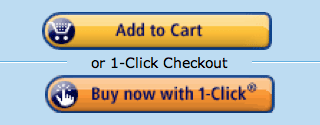- Home
- About
- Book
- Introduction
- Ch. 1: Business
- Ch. 2: Fundamental Theorem
- Ch. 3: Sales
- Ch. 4: Relationship Building
- Ch. 5: Branding
- Ch. 6: Archetypes
- Ch. 7: Consumers
- Ch 8: Our Products
- Ch. 9: Proposals & Figures
- Ch. 10: Papers & Conferences
- Ch. 11: Giving Talks
- Ch. 12: Internet
- Ch. 13: The Public & the Govt.
- Ch. 14: Science Itself
- Ch. 15: Starting a Movement
- Further Reading
- Workshop
- More Useful Links
Download free templates, or make the switch to digital-only.
This article originally appeared in Nature Index.
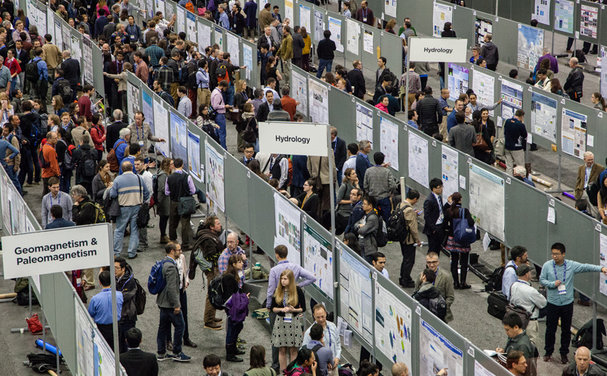
A few years ago, presenting a poster at a scientific conference inevitably meant battling with thumbtacks, rubber bands, and an unwieldly sail of paper with little power to inspire. Now researchers are increasingly opting for digital posters and templated designs that highlight – rather than obscure – their key findings.
I recently attended the 2019 annual meeting of the American Geophysical Union (AGU) in San Francisco, where 17,909 scientific posters were displayed over the course of a week. Many of these posters were visually arresting and cleverly constructed. And some were entirely online.
Since 2017, the AGU has been inviting presenters to submit digital poster ideas. Known as iPosters, they can support videos and animations, and are displayed on giant, interactive touch-screens.
That year, 117 iPoster submissions were approved for display at the conference. In 2018, that number had jumped to 775 iPosters, and last year, there were 995.
“The audience is jazzed about them,” says AGU executive program manager, Erik Hankin. “There’s an excitement around the technology and how it can overcome the limitations of a paper poster.”
The digital poster’s advantages go far beyond not having to lug around a 40-inch cardboard tube. Presenters can easily make last-minute changes to the content, and they can be instantly converted to other digital formats so they can be shared or uploaded to a website.
“I like not having to deal with the university printing office or worry about leaving it on the train,” says Leah Wood, a PhD student from Indiana University-Purdue University Indianapolis. “And I think it’s more engaging.”
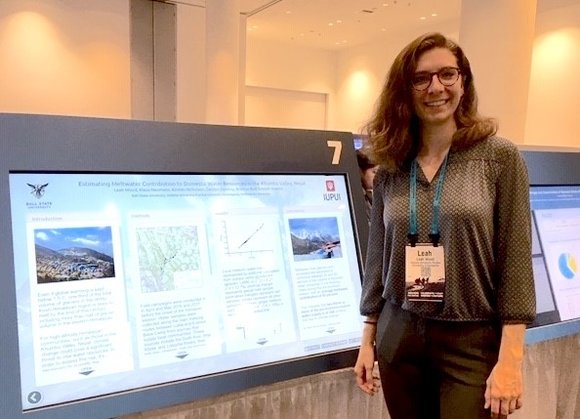
The AGU asked iPoster presenters to give brief talks about their research (called eLightning talks), and those were a hit as well.
“I think it’s the best of both worlds between giving an oral presentation and a poster presentation,” says Wood. “These three-minute talks are just right to give an elevator pitch and encourage people to come and play with the poster.”
Paper posters aren’t done yet
The downside of running a digital poster session is that it costs more than a conventional poster session, and someone has to foot the bill.
Conference organizers pay aMuze Interactive, a US- and Sweden-based company, for the use of proprietary iPoster software, and often a second company to truck in the special monitors and display hardware.
Some conferences can charge as much as $1,000 extra to participants who present digital posters to cover these expenses.
If that cost precludes you from going digital, progress has touched the paper side of the poster hall, too.
We’ve also seen improvements in the design of scientific posters. In 2019, Mike Morrison, a PhD student in psychology at Michigan State University, created a viral video calling out the inadequacy of conventional posters and introducing his own free downloadable poster templates called betterposters.
Morrison’s betterposter design includes small portraits of each author so conference-goers can recognize their faces in a crowd. They also include QR codes that can be scanned to bring up the relevant paper and other supplementary material on a user’s smartphone.
But the hallmark of the betterposter is a big dark square, smack in the middle of the poster, containing a single sentence that states the primary result of the research. It’s written so large that it’s impossible for conference-goers not to read it as they walk by
buy Ivermectin Brendan Riordan@concernecus
my first attempt at a #betterposter come find out what happens! #ELSO2019

8410:25 AM – Sep 14, 2019 · Austin, TXTwitter Ads info and privacy18 people are talking about thi
@drdavidliew presents his poster #2685 #ACRbest #ACR19 @RheumNow come check out the Australian Experience of TA bx.

710:35 AM – Nov 12, 2019Twitter Ads info and privacySee Dr. Rachel Tate’s other Tweets
My colleague, Petr Pokorny, a planetary science postdoc from the Catholic University of America in Washington and NASA’s Goddard Space Flight Center in Maryland, tried using a betterposter template for the first time at the 2019 AGU meeting.
“It was a huge success. I got about 100 people stopping to read the poster and take pictures of it,” says Pokorny. “And it was a pretty dead part of the room.”

Learn from the best
My hope for the future of conference posters is to see the aMuze iPoster templates incorporate some of the clever elements of the betterposter concept.
Although the digital posters I saw last year were easy enough to interact with, I often found myself struggling to understand the main point of the research being presented.
The betterposter templates are designed to put the “so what?” factor at the front and centre of the presentation – quite literally – which often solves this problem.
Here are some of my favourites that have been posted to Twitter:
Jacqueline Forrester@jacforrester
@ghs_org Health Sciences Center Research Showcase today – lots of great feedback on our #betterposter design! @Laura_MPH
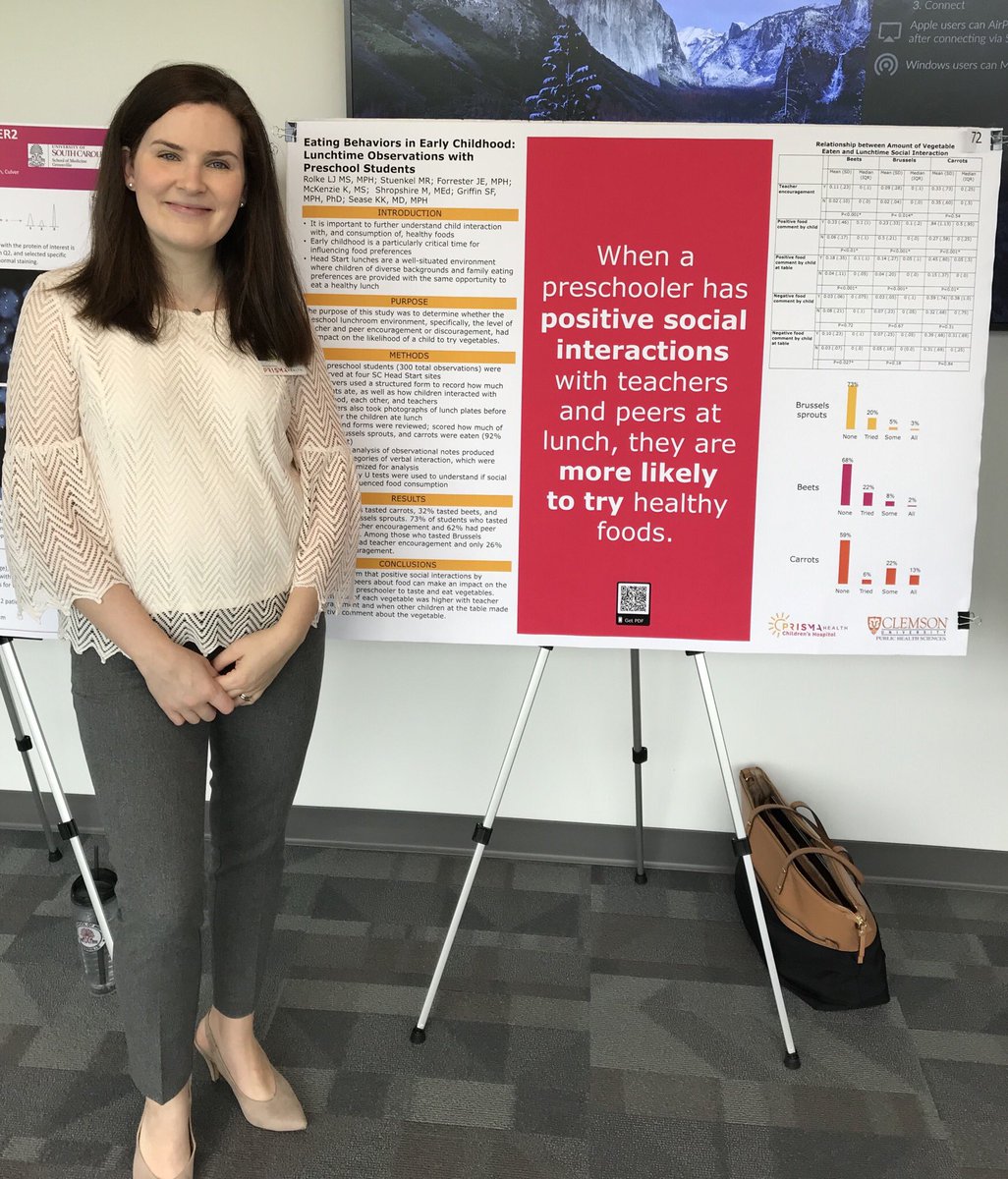
152:00 PM – Apr 12, 2019Twitter Ads info and privacySee Jacqueline Forrester’s other Tweets
Presenting research at @metals_in in Paris this week! Got creative with this one following some inspiration from @mikemorrison. *Note the skull decorated with orbitals to represent cytotoxicity! #CHEMISTRY #betterposter #Paris

256:13 AM – Nov 15, 2019Twitter Ads info and privacySee Miles S Capper’s other Tweets
Giving the #betterposter template a go at #NAPCRG2019 and have caught some eyeballs. Success
Come learn about primary care patient volume and quality of care for complex patients with me

961:01 PM – Nov 19, 2019Twitter Ads info and privacy21 people are talking about this
Lauren Heathcote, PhD@LCHeathcote
Thank you #IPOS2019 for the opportunity to present my research on #symptom perception in #AYAcancer survivors today.
My first #betterposter design was seemingly a success 🙂
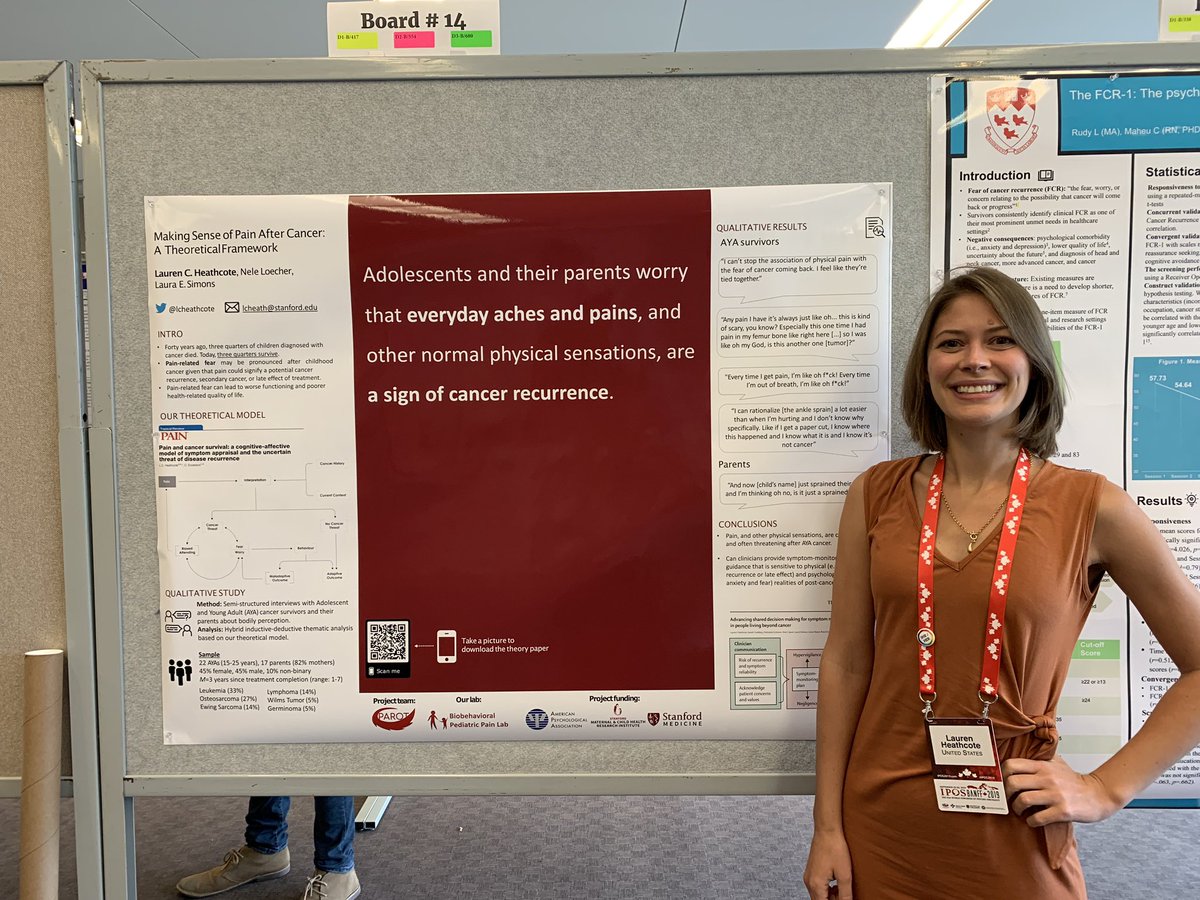
1075:41 PM – Sep 24, 2019 · Kinnear Centre For Creativity & InnovationTwitter Ads info and privacySee Lauren Heathcote, PhD’s other Tweets
Search the #betterposter hashtag on Twitter to see more examples.
And to avoid that crushing feeling that results from unfurling a crinkled poster, you can also order a cloth fabric poster at makesigns.com or postersmith.com.
(The post was first published at Scientific American Blogs.)
Candidate Hillary Clinton’s speeches were less compelling than those of now-President Donald Trump. We all understood this. But I, for one, would stumble over my own words each time I tried to describe what made Trump’s speeches so much more effective.
Fortunately, Randy Olson and Jayde Lovell will tell you what made Trump’s speeches so much more effective without stumbling—and they have summarized the method to make it handy for us scientists. I learned about their approach at their session at the South by Southwest (SXSW) conference in Austin, Texas last month. Their method, called “ABT” for “And, But, Therefore,” forms the basis of Olson’s most recent bookHouston, We Have a Narrative (University of Chicago Press, 2015).

As a candidate, Clinton spoke in lists, as many scientists and other intellectuals do, marshaling a wide range of facts and expressing many angles on each topic. Olson and Lovell would say that Clinton spoke mostly in “ands.” Trump, on the other hand, asserted only his opinions and plans, leaving no room for disagreement. Olson and Lovell would say that Trump speaks in “buts,” each sentence ablaze with narrative.
This claim rang true to me immediately. I think I even feel the word “but” was implied by Trump’s favorite index-finger-in-the-air hand gesture. It reminds me of a similar gesture I taught my kids to use when they need to say something but they have their food in their mouths.
Olson and Lovell go a step further and argue that the ratio of “buts” to “ands” in a speech serves as a useful diagnostic of good narrative. Olson has analyzed many well-known speeches and writings, counted the number of “ands” and counted the number of “buts” in each one. The but-to-and ratio predicts Abraham Lincoln’s victory over Stephen Douglas, he explained. Clinton’s speeches tend to score near 1/5 (one but for every five ands). Trump’s but-to-and ratio generally ranks the highest among all presidents, typically coming in around 1/3.
Indeed, others have pointed to the hazards of overusing the word “and” and the importance of using the word “but” to make communications sound conversational or to appeal to regional crowds. In an attempt to improve the writing style of communications from his institution, the chief economist of the World Bank recently proclaimed that he would not clear a final report for publication if “and” comprised more than 2.6 percent of the text.
Jack Grieve, professor of corpus linguistics at the University of Birmingham, maps the use of words on Twitter to help understand the evolution of language. He pointed out to me that tweets originating in the South tend to use the word “but” more often than tweets coming from elsewhere in the United States.
But this simple index does not impress everyone. Professor Jennifer Mercieca at Texas A&M University, a historian of American political rhetoric, admonished me that Trump tends to fill the pauses with random conjunctions. “I think my rhetorical studies colleagues would feel a little uncomfortable just counting the numbers of ‘ands’ and ‘buts’ and ‘therefores,’” she said.
But … Olson and Lovell’s ABT method goes beyond “and” and “but.” For maximum power, Olson and Lovell recommend combining “ands,” “buts” and “therefores” into a verbal hat trick, and repeating this verbal pattern over and over to organize your narrative. You might drop the word “therefore” or replace it with the word “so,” for example. But regardless of the exact words chosen, Olson and Lovell argue that the strongest way to make a point takes the form: Agreement (and) Contradiction (but) followed by Consequence (therefore). Here’s an example of the ABT method in an abstract that my student Steven Silverberg recently submitted to the American Astronomical Society:
M dwarfs are critical targets for exoplanet searches, and debris disks often provide key information as to the formation and evolution of planetary systems around higher-mass stars, alongside the planet themselves. But fewer than 300 M dwarf debris disks are known, even though M dwarfs make up 70 percent of the local neighborhood. Therefore, we have undertaken a search for new disk-hosting M dwarfs using the Disk Detective citizen science project….
I added in the word “therefore” for the purpose of this illustration, but it was implied anyway. Here’s another more colloquial example from Oprah Winfrey’s recent Golden Globes speech. Oprah tells you the news and then tells you what had better happen next, spelling it out with an “and”, a “but” and a “so”:
“I’ve interviewed and portrayed people who’ve withstood some of the ugliest things life can throw at you, but the one quality all of them seem to share is an ability to maintain hope for a brighter morning, even during our darkest nights. So I want all the girls watching here, now, to know that a new day is on the horizon!” — Oprah Winfrey, January 7, 2018
On Olson’s blog, you can read a breakdown of Oprah Winfrey’s entire Golden Globes speech, color-coded by element. The speech consists of four cycles of Agreement, Contradiction, Consequence, sometimes literally linked by “and,” “but” and “so” and sometimes not. Olson provides a similar breakdown of Martin Luther King’s I Have A Dream speech.
Although she didn’t trust the but-to-and ratio as a gauge of narrative, Mercieca smiled at the ABT method. “It’s the Hegelian thesis, antithesis, synthesis model,” she explained, referring to a triad often ascribed toGerman philosopher Georg Hegel, and sometimes taught in writing classes. Indeed, Olson refers to Hegel in his blog and his book as the true originator of the ABT concept.
Certainly, there have been times in my writing and speaking when I have instinctively begun blurting out all of the facts I could think of on a topic, to the pain of my audience. Other times, I have written myself into tangles of ”however”s, “yet”s and “while”s. It’s not my fault. As scientists, we are trained to assemble all relevant pieces of evidence, narrative be damned.
But next time this happens, I will recall Olson and Lovell’s (and Hegel’s) wisdom. Because it should be clear to all of us now that when we venture into the public eye, we must hone our storytelling skills if we intend to lead the world to a safer, more scientific place. “People can’t really think without narrative,” Mercecia told me. “Narrative is leadership,” Olson informed us.
So I challenge you: fire up your video recorder or word processor and calculate the but-to-and ratio in your next public communication. If it’s under 1/5, you might want to sign up for one of Olson and Lovell’s Story Circles training courses. If it’s over 1/3, you might be ready to run for office. Let me know how you’re doing @marckuchner (and share your numbers with @ABTagenda, @JaydeLovell, @JWGrieve and @jenmercieca too).
Then go forth and save the world.
(This article was first published at Discover, PLOS blogs, and the SciStarter blog,)
Eighty-seven years ago, this week, Clyde Tombaugh was poring over a pair of photographic plates, hoping to change the world. He was staring hard into an arcane device called a blink comparator, which allowed him to rapidly switch from viewing one image to the next. In those days before computers, that was the best tool he had for finding the faint, moving dot he was seeking, a new planet in our solar system.
When Tombaugh discovered Pluto in those photographic plates on February 18, 1930, the news made headlines all around the globe. “In the little cluster of orbs which scampers across the sidereal abyss under the name of the solar system there are, be it known, nine instead of a mere eight, worlds,” said the New York Times. It was a victory for Tombaugh, and for astronomy.
 Artist’s concept of the Planet Nine, cold and massive, orbiting hundreds of times farther from the Sun than Earth. Credit: NASA
Artist’s concept of the Planet Nine, cold and massive, orbiting hundreds of times farther from the Sun than Earth. Credit: NASA
Times have changed since that big day. Computers and the internet have changed the way we handle large data sets and interact with one another. Telescopes are bigger, and some fly in space, giving us access to wavelengths of light that astronomers in the 1930s could only dream of seeing one day. Pluto is no longer considered a planet, but a dwarf planet, the king of the Kuiper belt, which is a collection of icy bodies orbiting the sun beyond the orbit of Neptune.
But the quest to understand the outskirts of our solar system has only picked up speed. Now evidence for a new planet in the outer solar system has surfaced, one more distant than Pluto. A pattern in the orbits of Kuiper belt objects points to a large perturber—possibly a new Planet Nine. This hypothesized planet could be as massive as Neptune, or even larger, but it has escaped detection because it is so cold and faint.
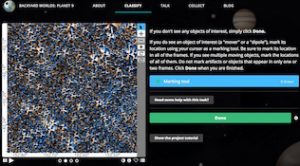
Backyard Worlds: Planet 9 shows you animated images of the sky taken at four different times. To participate in the search, click on the moving objects. Credit: Zooniverse
So today we’re announcing a new search for moving objects in the realm beyond Neptune: a citizen science project called Backyard Worlds: Planet 9. Hosted by Zooniverse, the project invites you to follow in the bold footsteps of Clyde Tombaugh by combing images from NASA’s WISE telescope to find objects that move, like brown dwarfs and planets. Participants will share the credit for their discoveries in any scientific publications that result from the project.Moreover, images of moving objects from NASA’s Wide-field Infrared Explorer (WISE) mission point to a population of ultracool brown dwarfs, or rogue planets, whizzing by the solar system beyond Neptune. Some of these nearby worlds may even lurk between us and the closest known star, Proxima Centari. These brown dwarfs hold keys to understanding how stars and planets form and how planetary atmospheres behave.
You won’t need a blink comparator like Tombaugh’s, just a laptop or cell phone. You’ll view animated images of the sky, in color, and simply click on interesting candidates when you spot them. You’ll join thousands of other citizen astronomers, whom you can chat with on the “TALK” social network, and a team of astrophysicists from NASA, the American Museum of Natural History, Arizona State University, and the University of California – Berkeley.
When you log into Backyard Worlds: Planet 9, you’ll see images of the sky taken at four different times, one after another, from the WISE telescope. Planet Nine is expected to look like a blue dot, hopping and jumping all the way across the images. Brown dwarfs will be redder, and slower moving. Some moving objects will appear as “dipoles”, pairs of bright and dark images. You’ll also learn how to search other catalogs to see if someone else has already discovered the object you’ve found– or if you’ve made a new discovery.
Making a big discovery these days still takes hard work. But it can be a lot more fun, thanks to citizen science. Before Tombaugh made his big discovery, Percival Lowell, the astronomer for whom Pluto is named, searched for Pluto for ten years, to no avail. Perhaps if he had help from citizen scientists, he might have lived to see its discovery. He might have made thousands of new friends as well.
This article was first published in Scientific American.
Alex Rogan masters a video game called “Starfighter” where he defends “the Frontier” from “Xur and the Ko-Dan Armada” in a space battle. Soon after he becomes the world’s highest scoring player, the teenager meets an alien who informs him that the battle is real! The video game was a test and a recruiting tool, meant to find those with “the gift” to pilot a real Starfighter spacecraft. Now it will be up to Alex to save the Galaxy.

Artist’s concept of the AWI0005x3s circumstellar disk. Credit: Jonathan Holden
That’s the plot of the 1984 space opera The Last Starfighter. And I think it’s a useful model for citizen science projects, where untrained laypeople are invited to take part in performing professional scientific research.
Since January 2014, I’ve had the honor of leading a citizen science project called Disk Detective, which is funded by NASA and part of the Zooniverse citizen science community. The project aims to find new planetary systems using data from NASA’s Wide-field Infrared Survey Explorer (WISE) and other surveys; we recognize these systems by the infrared light radiated from circumstellar disks. At DiskDetective.org, users view ten-second videos of each astronomical source, and help us rule out false positives by clicking buttons to describe what they see.
Our top users are not teenagers in trailer parks like Alex from The Last Starfighter. But they certainly do have “the gift,” i.e., a passion for science. While roughly 30,000 people have participated in the project at some level, so far, more than half of the online classification work at DiskDetective.org has been performed by a group of roughly 30 dedicated citizen scientists, working round the clock, chasing the next big discovery.
Even more impressive to me than the roughly 1,000,000 classifications performed by this group at the Disk Detective website are the thousands of additional hours this team has spent working on the project offline, so to speak. This “advanced user group” organized themselves, starting their own Google group and Facebook group to communicate with one another. They have helped the project by:
- Building and maintaining spreadsheets of thousands of the best targets for follow-up on six telescopes around the world.
- Researching thousands of disk candidates in the professional astronomical literature to find out who may have observed it before and to determine the most likely spectral type of the star.
- Downloading professional astronomical software, and sorting through thousands of follow-up images to check our disk candidates for additional background objects.
- Driving 12 hours across South America to the CASLEO observatory help with an observing run.
- Translating the DiskDetective.org website into Spanish, German, French, Italian, Portuguese, Russian, Polish, Bahasa, Hungarian, Mandarin (Simplified and Traditional characters) and even tweeting updates in Spanish, so people around the world can participate more easily.
- Attending professional astronomical conferences and proofreading our professional publications.
- Double-checking subsets of our rejected sources to look for certain kinds of rare astronomical objects
- Giving talks and writing Wikipedia articles about our results, and creating original artwork that we have used in our press releases;
- Introducing us to professional colleagues who could take follow-up observations of our disks at new telescopes could follow up our favorite disks at new telescopes–and did!
These contributions have taken us far beyond the original scope of the project. Moreover, our advanced users have also helped teach one another about the science of disks and stellar spectroscopy, creating elaborate online guides for one another to read, and coaching one another one-on-one. That task hasn’t always been easy given that English is a second language for many of our users.
Sometimes my colleagues will ask me: could Disk Detective possibly have been done by computer? Could a clever machine-learning algorithm replace the hard work of the citizen scientists? Indeed, a series of innovative computer analyses by several teams of professional scientist have uncovered many of the brightest disks in the WISE archive in the six years since the data became available. So the competition between computer-aided professionals and teams of citizen-scientists is keen.
But Disk Detective has already made several discoveries that the teams of professionals did not, despite having access tothe data several years before our project launched. We published our first two papers this month. One described what appears to be the first debris disk ever found around a star with a white dwarf companion. The other announced a new disk candidate around a cool star that appears to be a member of the Carina association of young stars: the oldest “M dwarf” disk in an association. Moreover we at Disk Detective have found many mistakes in the published computer analyses; false positives where a human eye was truly needed to make the right call.
But I think our best discoveries of all have been our “Last Starfighters,” the passionate citizen scientists in the Disk Detective advanced user group: a retired doctor, a retired biologist, a computer scientist, students of law and geodesy, a postal worker, grandparents, teachers, a single mom—each with unique talents and perspectives. Even after Disk Detective has found its last disk, they will probably continue to serve humanity through their science. Some even have applied for jobs in astronomy inspired by their work on Disk Detective.
So the next time I launch a citizen science project (and that will be soon) I will certainly ask myself: could the basic online classification task be done better by computer? But I will also remember that a citizen science project run right is a talent search. Right from the start, I will build in new ways to inspire and connect with the project’s most active users. And I will do my best to stay in touch with the international community of citizen science superstars that is emerging, and find new ways to work with them throughout my own career. There is a lot of scientific talent out there, just waiting for a chance to save the Galaxy.
Being a scientist means giving lots and lots of talks. You have may have heard me mention the National Speakers Association, the society for people who give talks for a living. I’ve been fascinated by this organization for several years, and trying to learn what I can from them about how we scientists can give better talks.
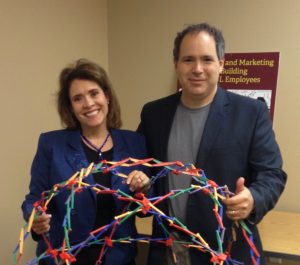
Bernadette, me, and a Hoberman sphere at Los Alamos
When I went to my first National Speakers Association meeting. I sat down a banquet table full of strangers and nervously introduced myself to the woman on my left. She was Bernadette Vadurro, President of Speakers Live, Inc., the past president of Capitol City Toastmasters and the 2009 President of the National Speakers Association New Mexico Chapter. As luck would have it, Bernadette was working at that moment with a group of scientists and engineers at Los Alamos National Laboratory, so we struck up a conversation.
Now I might somewhat be less introverted than some scientists. But Bernadette really has the professional speaker’s gift; all eyes are on her when she walks into a room. I didn’t think I could be much use to someone so versed in the craft of professional speaking. Indeed, we lost touch after the meeting.
But to my surprise and delight, Bernadette called me up last year and insisted that I give a workshop with her on Presentation Skills and Marketing at Los Alamos National Laboratory. We’ve continued to work together this year on a series of workshops about my favorite subject: providing scientists with marketing and communications tools.
I’ve learned all kinds of new tricks from Bernadette and I count her as my speaking mentor. So without further ado, let me offer you some choice tips for giving good presentations—from an interview with author and professional speaker Bernadette Vadurro, C.S.P.
MK: OK. You have lots of letters after your name. What exactly is a C.S.P.?
BV: A C.S.P. is a certified speaking professional. It’s designated by the National Speakers Association. It is grueling to obtain! I have a friend who has an M.B.A. from Harvard and she said it was easier to get the M.B.A. from Harvard than her C.S.P.
MK: What’s the secret to being a really great speaker?
BV: Well, there are a lot of components to giving a really great talk. Think of sitting down to a meal in a fabulous restaurant: the presentation is beautiful, the food is delicious, and everything is perfect from the waitstaff to the table settings. That’s how you want your talk to be.
MK: What special struggles do you think scientists have as speakers?
B.V. Scientists frequently appear to practice one-upmanship. I.e., how smart can I sound? How can I overwhelm you with my content? They forget that when you’re talking to a public audience you have to bring everyone along with you. I use the analogy that if you can think of your talk like a cruise ship—you wouldn’t want to leave anybody on shore.
The other big thing is that scientists, because of their focus on empirical work, forget to have a call for action. That’s why we have so many Americans looking to a groundhog to tell them what the weather is going to be and ignoring climate scientists with the real facts. We have many critical issues that the public looks to scientists and engineers to fix, but because of the disconnect between the information and data that scientists present and the understanding by the general public—on how they can actually act upon the information to make a difference we end up with confusion on the cause of a warming climate, warming and polluted oceans, earthquakes caused by fracking and all sorts of problems. People need to be led by the hand and told specifically: how do we fix things.
MK: What is a call to action?
BV: The call to action is telling people literally what they should do after hearing your information.
MK: What’s the difference between giving a scientific talk, and say, giving a TED talk or a keynote presentation at a banquet?
BV: There a huge difference. A scientific talk for colleagues is given in scientific jargon—and you are free to speak in scientific terms because there’s an understanding in the scientific community. You can’t expect that non-scientific people will understand you in a public talk. In speaking to the public if you talk about “moles” or “quarks” it sounds like something that should grow as a result of mildew. Scientists can’t expect to the general public to know these things. You have to start more basic than that. If you don’t have the WIIFM (What’s In It For Me), the eyes glaze over and the cell phones come out and people start walking out of your talk.
MK: Here’s one of the handy tricks I learned from you. How do you handle people who are being rude and talking during your presentation?
BV: Well you use you body language by moving towards them–and the perpetrators will stop talking! If you’re stuck on the stage, you can look directly at them, or ask for feedback from the group. Always assume the reason the perpetrators are talking is because you hit on something emotional and they are excited about your topic. My rule is to never embarrass, act condescending or be rude towards a participant.
MK: Here’s a thorny issue that came up during the last workshop we gave together. When do you think is it OK for women to smile during a presentation?
BV: I think that smiling is the number one way to gain rapport with your audience. The smile is such a pleasant thing on a face. Smile when you want to increase the buy-in to your ideas. It is a subliminal way to increase your influence with the audience.
So I think both men and women should smile. But you don’t smile just for the sake of smiling–smile with a purpose. You do not smile when you’re trying to be really serious. For example you can put out really serious information with a serious face and as you see people connecting to your idea you then reinforce it with a smile and a head nod. I also give a smile as a reward to a participant or to reward the audience for participating with me. You can always tell when you have your audience hooked by watching their body language.
MK: How does marketing fit in with presentation skills?
BV: In today’s world, marketing means selectively seeking out your target audience—the people who want what you have to offer, your services or products. It means finding your tribe.
Presenting is the opportunity to connect with those people in your tribe. And this is a make or break moment when people decide if the message you’re going to deliver worth their time. People make up their minds in a matter of seconds about whether they plan to tune out or perk up and listen.
MK: Is there anything else I should have asked you about?
BV: Yes! Vadurro and Kuchner are available for customized in-house training programs specifically for the scientific community!
MK: So here’s that call to action?
BV: Yes! Send me an email at Berna@speakerslive.com and ask about our workshops.
Just as the pundits predicted, video is taking over the internet. Youtube has now become the second most popular site on the internet, beating out Facebook. And with the rise of video, science video blogs (vlogs) are taking off everywhere. There are the big budget science vlogs by TED and Google, and popular lone wolf educational vloggers like Dianna Cowern (Physics Girl) or Derek Muller (Veritasium). But there are still many niches to fill, and there’s always new science that needs to be shared, so there’s plenty of room for scientists to meaningfully add their own footage to the online world.

Last week, I had a chance to observe and participate in the birth of a new science vlog called “Cool Worlds” created by astronomer David Kipping, an assistant professor at Columbia University. For years, I’ve been encouraging scientists who have an interest in outreach to make their own videos. David is doing exactly what I pictured: using the medium of video to explain his own latest papers and relevant work of his colleagues. Cool Worlds may not be as jazzy as educational vlogs, nor as technical as a professional conference. But it offers casual viewers a chance to hear about cutting edge research from the people who are doing the research–and that’s something that will always be fresh.
David shoots the “Cool Worlds” videos in his office using a Nikon D5200 DSLR camera, with a 50mm F 1/1.4 Nikon lens and a RODE VideoMic Pro. He got the camera for Christmas a few years ago (it costs about 500$). He already had a tripod to put it on (you can get one for <100$). He made two purchases for the purpose of starting the vlog: he bought the lens for about 300$ and the mic for about 200$.
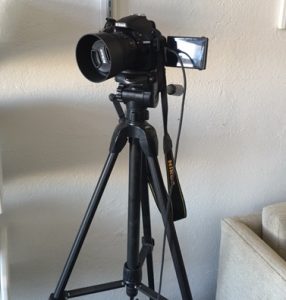
David got the camera that he uses for Cool Worlds as a Christmas present.
He started by using a standard 18-55 mm zoom lens (there’s often a lens like this included with the camera), and found that his videos were coming out too dark. So he bought the new lens, which collects a lot of light so there’s no need for specialized lighting. It also makes the background “nice and soft” but keeps the person in focus.
David edits the video using the iMovie software that comes for free on a Mac laptop. The camera records the audio iself through its mic-in port, so there’s no extra work to do to sync up the audio and video. The videos play for about 3-6 minutes, and it takes David about 2-3 hours to make each video. He’s been putting out roughly one each week for for the last two months.
David started his vlog because he spotted an opportunity to connect with a vast audience. “I noticed that the vlog format is very successful on YouTube. Like I’ll see a series of videos online, like reviews of TV shows like Game of Thrones, and they’ll get a million views. I hadn’t really seen too many astronomy outreach talks done in a vlog format.”
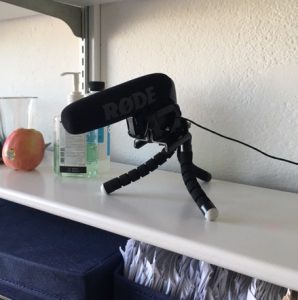
It’s important to have a good microphone! This Rode mic sits on David’s bookshelf.
Cool Worlds may not yet have reached as big an audience as these Game of Thrones videos, but already, a Cool Worlds video about a cloaking device for extrasolar planets featuring Alex Teachey has had almost 20,000 views. That’s a lot of fun. “There have also been lots of comments about the video,” David said. “We filmed a Q. and A. video just to respond to all the comments. There have been some strange comments on there, but most have been genuine questions that we’ve enjoyed replying to.”
David had me sit in his desk chair and talk about one of my science projects, as his camera silently recorded me. I stammered and sputtered a bit. But after about 20 minutes of improvising, there was plenty of material for him to edit into this mini-masterpiece here. “You don’t even need to spend a lot of time making artist impressions or animations.” says David.
So far the Cool Worlds vlog is mostly one scientist with a camera, a low budget–and a lot of guts. But take a peek; I bet you’ll be inspired. And as David says, “if you can inspire a few people to become astronomers–that’s incredibly worthwhile.”
This book review was first published in Physics World.
The press coverage of this year’s Grammy awards taught me a new term: “producer inflation”. The term refers to the way making hit records seems to require bigger collaborations now than it did in years past, when teams of one or two producers sufficed to create all of the tracks. Pop star Taylor Swift’s latest Grammy-winning album, for example, boasted no fewer than 11 producers, while another hit album, by an artist called The Weeknd, listed 15.
The trend towards large collaborations is apparent in science, too. A paper with more than 5000 authors appeared last year in Physical Review Letters (2015 G Aad et al. (ATLAS Collaboration, CMS Collaboration) 114 191803), while the paper announcing the recent discovery of gravitational waves had more than 1000. This development, along with a perennial hunger for career advice among young scientists, has set the stage for Alaina Levine’s book Networking for Nerds: Find, Access and Land Hidden Game-Changing Career Opportunities Everywhere.
Networking for Nerds aims to teach you how to build relationships within this large pool of potential colleagues, mentors and collaborators via conferences, job interviews and online networking. As well as offering a dizzying array of networking dos and don’ts, the book takes readers on a tour of useful concepts and strategies such as branding, SWOT analysis (strengths, weaknesses, opportunities and threats), etiquette and social media. This is all standard stuff in some circles, particularly the business world, but it’s material that most scientists neglect during their education. The tips in the book include intriguing insights about when it’s appropriate to put your photograph on a business card (answer: it’s expected if you’re a realtor, but not if you’re a physicist), and even where you should place your knife and fork on your plate when you are done eating a formal meal (answer: in the US, they go at the 3 o’clock position; in Europe, at the 6 o’clock position).

Here I must disclose that, thanks in part to Levine’s own prodigious networking skills, I came to know her long before reading her book. For years, she’s been an active participant in the “Marketing for Scientists” group I founded on Facebook. So, as Levine’s valued professional contact, I take some pride in recommending her work to you. Indeed, the book explains exactly why professional contacts generally enjoy recommending one another. There’s nothing wrong with this sharing of information – so keep reading.
Levine understands us nerds because she has a bachelor’s degree in mathematics from the University of Arizona. She is also a science writer and a comedian. You should not, however, expect much comedy in Networking for Nerds. The tone is rather dry, despite the picture of goofy eyeglasses on the front cover. Bulleted lists of key points abound, and each chapter ends in a list of “Chapter Takeaways”. This textbook style is, perhaps, the book’s main limitation. While most readers of a book like this are probably not seeking a literary experience, while I was reading I found myself hungry for more narrative and a broader range of perspectives. Stories from nerds in various fields and from other career advice experts would have helped illustrate how the book’s techniques can apply across the diverse spectrum of scientific and academic subcultures. The prose provides many brief stories of Levine’s personal networking successes, but few stories of her failures that would help readers connect with her.
For a career advice book that’s easier to read and more comprehensive (at least for those aiming to stay in academia), try The Professor Is In: the Essential Guide To Turning Your PhD Into a Job. The author, Karen Kelsky, has a PhD in cultural anthropology from the University of Hawaii and rose to the rank of associate professor at the University of Illinois at Urbana-Champaign, serving for a while as the head of the Department of East Asian Languages and Cultures. If you think physics jobs in academia are rare, try getting a faculty position in an East Asian languages and cultures department! The odds are about the same as becoming an astronaut.

The Professor Is In takes on the “peon” mentality that holds back so many graduate students and explains how to think differently in order to succeed. Kelsky plays the academic curmudgeon, overworked and too busy to be bothered with your simpering – thank goodness she’s on your side. Don’t read this book to pick up new social-media tricks, or learn how to sniff out hidden opportunities such as unadvertised STEM jobs. But if you expect to walk right through the front door of academia, you’ll need Kelsky’s advice on putting together your application packages, writing your essays and keeping your hopes realistic.
As a mentor of students and postdocs, I expect I’ll find both of these books useful additions to my library. I’ll hand Networking for Nerds to the shy first-year graduate student to help them break out of their shell when they go to their first science conference. The fourth-year student who is starting to peer sideways at those faculty job listings will get The Professor Is In. But whichever book you find yourself handing your students, you might want to temper it with a bit of encouragement, because all this advice can get onerous. Ultimately, my favourite moment in these books came in chapter two of Networking for Nerds, where Levine acts on her sympathy for the beleaguered junior researcher by delivering, in a few words, a much-needed confidence boost. “You are a lot more important than you might have thought,” she writes, like a coach cheering a prize-fighter mid-bout. She’s correct. As a trained scientist or engineer, you are vastly important to the very future of humankind, wherever you end up working. And whether you’re wandering a vast, crowded conference room, or placing your CV on a huge pile of applications, your future rests on a strong belief in yourself.
This week I’m writing to you from the National Speakers Association annual meeting, a great place to learn new marketing tricks. I’m going to share with you a tip I just learned from journalist Geeta Nadkarni. It’s an idea that sounds simple and obvious–and I bet you haven’t tried it yet.
First, let me introduce Geeta. Her dress is covered with glass beads that sparkle furiously at me. She gives me a hug even though she’s never met me before. She is not afraid of being seen and making new connections! (The National Speakers Association is full of extroverts.) You can learn more about Geeta via her regular column in the Huffington Post, or click around her website, which is full of useful marketing advice.
So here is the trick. Whenever you have a media appearances say television or radio interview or newspaper, grab a small version of that media outlet’s logo (like the ones on the right) and paste it into your own webpage. That communicates to journalists that you are an interesting person to talk to. As Geeta pointed out, the media loves people who are in the media. Fame begets fame, and posting these logos on your own webpage helps you stay part of that cycle.
Guess what? Scientists are already using this trick. Take a look at the website of physicist Michio Kaku. You can’t miss the media logos everywhere: MSNBC, Fox News, CBS, Wall Street Journal and more. Astronomer Neil DeGrasse Tyson’s webpage is a bit more subtle, but still has mini logos for the New York Times and Natural History magazine.
Dang it! I should’ve thought of this myself. Because my colleagues in the music business never hesitate to cover their websites with logos of their clients. For example, here’s the website of a music producer friend, Gary Earl, showing off the logos of some of his clients. It’s not the landing page of his website; it’s s separate page. But it’s not hard to find.
But I never thought of using this approach as a scientist. It seemed to me a little bit unbecoming of a scientist. It might give the impression that I was more interested in self-promotion than in research.
So here’s my suggestion. If you have the guts for it (and you already have tenure), do like Michio Kaku does and put the logos right up front on your website. Or if you’re nervous about what your colleagues will think, do like my musician friend Gary Earl, and add a separate page to your website that shows off your media credits, and all the logos. It will help you stay in the public eye, bring your message to the people who need to hear it, and heal the world through science.
And when you have a chance, try to drop by a National Speakers Association meeting! They are good fun, even if you’re not an extrovert.
I became a father two years ago last month. In those two years I blogged a little less often and gave few workshops than I would have otherwise. But I kept learning valuable lessons about marketing and  communicating science—from life with my toddler. Here are a few of the priceless lessons he has taught me.
communicating science—from life with my toddler. Here are a few of the priceless lessons he has taught me.
You can’t win by fighting.
My two-year old son loves puppies, grapes, fire trucks—and above all—tongs. Yes, tongs: those springy tools you might use to grab chicken thighs from the grill or toast from the toaster. Whenever I open the drawer and take out the tongs, a row begins. “My tongs!” he cries, grabbing hold of them. If I try to yank them away, it becomes a tug of war. Screaming, crying, kicking—he pulls out all the stops. If I do manage to wrest them from his grasp, the screaming only intensifies. Fighting a two-year old is simply a waste of time.
Instead of fighting: redirect.
So the chicken thighs are burning and I need those tongs to take them off the grill. But my toddler has them and is using them to spread cheerios around the rug. So how do I get the tongs back? I offer him something else in exchange for the tongs, another enticing toy he can grab hold of. It works most of the time.
Use silly words.
There’s a chain of convenience stores in my part of the world called “Wa-Wa”. I stopped at one the other day with my son. He couldn’t stop giggling when he heard the name. And it was such an easy word to read and say and remember—and he could even almost read it himself. Now he asks to go to Wa-Wa all the time. Where do you want to go for your birthday? Answer: Wa-Wa! And if he really gets upset over the tongs and he won’t settle for a toy fire truck—you guessed it—I can always take him to Wa-Wa.
Much of this may seem obvious to you, but it dawned on me one day that my son was teaching me important tools for shaping the public debate over scientific issues. We scientists always seem to be in some kind of battle for public opinion these days, right? Certain topics in science—like climate change, for instance—just take them out of the drawer and they are guaranteed to start a fight. Well, that’s where these toddler techniques can really shine.
Living with a toddler has taught me that the fight over climate change, per se, is not a fight you can win. The big toddlers of the world—the Marco Rubios and the Sarah Palins and so on—will not let go of their end of this argument. They will just continue to get more and more upset, and continue outspending those of us with the right answers.
But we can still ultimately control the discussion, provided we let go of the tongs. The trick is to redirect our opponents by distracting them with new toys, that is, new topics for debate—of our choosing. And the best way to frame these new topics is with silly words (like “Wa-Wa”). The silly words are new brand names.
Of course, climate change is not a silly topic. And a proper discussion of climate change often does call for precise terms like external forcing and general circulation models, and other non-toddler friend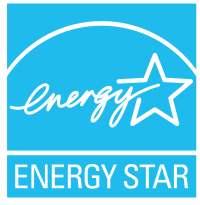 ly jargon.
ly jargon.
But we do have some good, evocative, fun, easy-to-pronounce words about climate change that have already started shifting the center of this debate: Tesla. Carbon Footprint. Energy Star. Smart Metering. Any toddler can say these words. These words lead us down a path toward fixing the problem, and crucially, give us a good feeling just to say them. And we can invent more. By offering people enticing new brands like these, we can redirect them away from a hopeless tug of war over climate change itself, and get them talking about how the problem should be addressed. Maybe we can even save them from themselves.
I’ve never been very good at asking for things or telling people to do things. The other kids were better at it. Can I have the big one? Gimme gimme! That was never my style, and I bet it wasn’t yours.
 Now, as a grown up and as a scientist I must regularly ask for things. Often, when I ask for something from my colleagues it’s in the form of a proposal–a formal document. My request is indirect. It sounds something like this: “I propose to apply this new class of models to the archived data. Please see the attached budget.” I generally wouldn’t think of walking up to my colleagues or my scientific customers and commanding them to something. It seems disrespectful.
Now, as a grown up and as a scientist I must regularly ask for things. Often, when I ask for something from my colleagues it’s in the form of a proposal–a formal document. My request is indirect. It sounds something like this: “I propose to apply this new class of models to the archived data. Please see the attached budget.” I generally wouldn’t think of walking up to my colleagues or my scientific customers and commanding them to something. It seems disrespectful.
But the principles of sales tell us to do just that. When we talk to the public, even to our colleagues, it can actually help sometimes if we are direct and commanding in our requests—like an impetuous five year old. A good way to build a commercial, a website, even a tweet is to include what’s called a call to action. That’s where you command–yes, command–your audience to do something for you.
Call us! 1 800 I FLY SWA
Buy the new Paperback edition. Click here!
Come in! We’re open.
It may feel awkward. But if you were really excited about something and you want to tell your friends about it, you might take this eager tone. And your friends won’t mind one bit. Here are some examples of how a scientist might use this approach.
People! Go look at this image from the Hubble Space Telescope!
Really you’re still programming in IDL? Stop typing right now and read this book about Python.
Click here to send me an email and start a productive collaboration that will change your life.
This approach works on Twitter. Noted Twittter analyst Dan Zarella found that tweets containing the words “Please Help” and “Please Retweet” garnered roughly twice as many retweets as typical tweets. It stands to reason, right? In Twitter’s own analysis, the most effective calls to action ask for a retweet, a follow, or a download.
A call to action works on a webpage. There is a cornucopia of blog posts online about how to sell something online using a call to action, usually in the form of a button that you click to download something, start a video, enter a credit card, etc. Here’s a long pdf with, 101 examples of webpages using calls to action. Amazon.com is a classic example. “Buy now with 1-click”.
What do you hope to achieve with your scientific webpage? I use my webpage to entice colleagues to collaborate with me! So the call to action on my webpage is to “Download ZODIPIC” a little piece of scientific software that I wrote that hope my colleagues will use (and ultimately be somewhat grateful for). I think every scientific press release should end in a call to action. To learn more about the California condor, join the CondorWatch citizen science project.
A clever, direct call to action even works in person or in a personal email. When you have to ask someone for a favor, do you ever find yourself stalling or beating around the bush? Then ending with a timid, “Would you mind possibly…?” This article in Lifehacker shows some great examples of how people asked for favors with shocking directness, and got what they asked for.
Sure you don’t want everything that comes from your mouth or your Twitter feed to be a call to action. If you cry wolf, you’ll dilute the urgency of your message. But don’t miss out on this simple marketing trick. Think of something science-y you want your audience to do because, by golly, it’s awesome. And go tell them to do it.
Improve your skills! New Workshops Available Now.
Marketing for Scientists is a blog, a Facebook group, a series of professional development workshops, and a book published by Island Press, meant to help scientists, engineers, and doctors build the careers they want and shape the public debate. Because sometimes, unlocking the mysteries of the universe just isn't enough.Or read reviews of the book at Astronomy.com, Chemists Corner, The Chronicle of Higher Education, Ecology or Research Explainer
Stay in touch...we'll send you a useful marketing tip every now and then.Posts
Blogging Branding and Archetypes Citizen Science Getting a Job Hollywood Leadership Marketing To Our Colleagues Mobile Barcodes Open Science Policy and Policymakers Salesmanship Science Education Social Networking Speaking and Presentation Skills The Press The Public Uncategorized Videos Writing a Book




